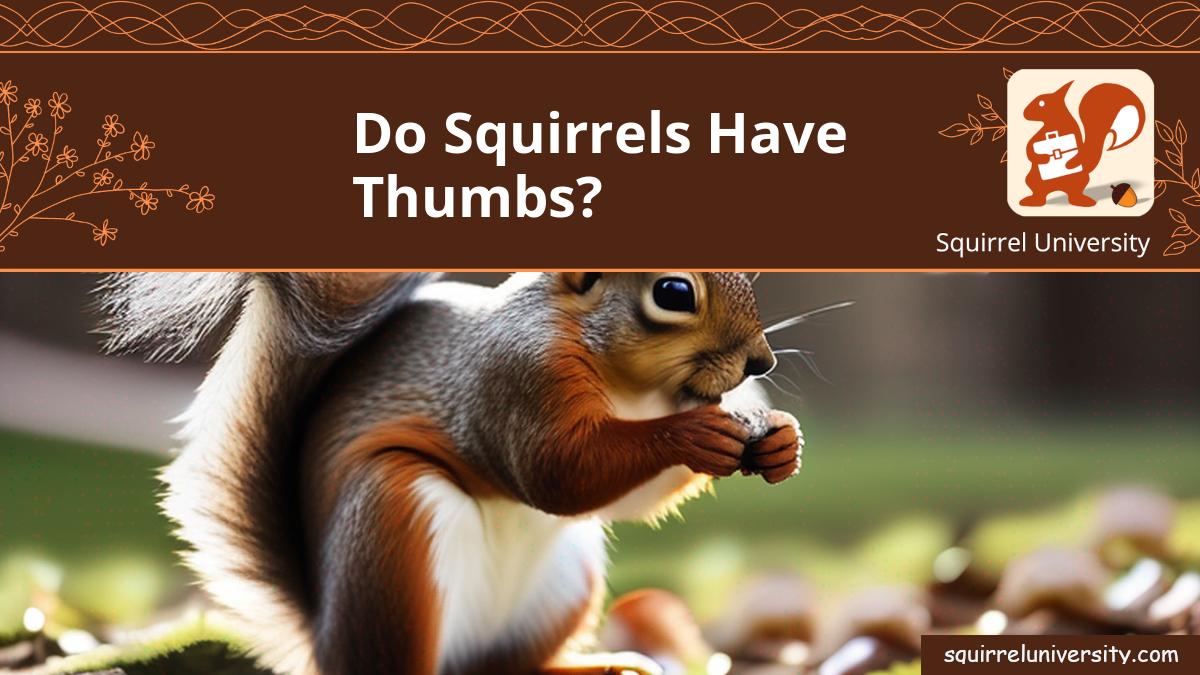Squirrels are incredibly agile creatures that can climb trees and manipulate objects with ease. But how can squirrels achieve this? Do squirrels have thumbs?
No, squirrels do not have truly opposable thumbs. However, they have small non-functional thumbs along with four long clawed fingers on their front paws to help them grasp objects. Scientists call those “vestigial thumbs”. Their versatile paws and sharp claws enable them to climb, forage, and survive in their arboreal habitats.
Do Squirrels have thumbs? An Overview of Squirrel Paws
Unlike humans and primates, squirrels are not equipped with opposable thumbs. However, they have a small “finger” that helps them to grab objects. Here’s how it looks like:

Let’s take a closer look at the anatomy of squirrel paws:
- The front paws of squirrels are adorned with four elongated and slender digits. The innermost digit is set apart and looks like a rudimentary thumb.
- Their “thumb” is not truly opposable but does aid in grasping objects.
- The four main digits have powerful claws for gripping branches and digging.
- Squirrels boast five long digits equipped with claws on their hind paws, while their ankles possess the remarkable ability to rotate 180 degrees. This unique ankle flexibility enables squirrels to skillfully maneuver and descend trees in a headfirst fashion.
How Is Their Thumb Different From Ours?
So in what ways are squirrel thumbs different from human thumbs?
- Their thumb cannot move independently of the other digits or oppose them like ours.
- It is small and not fully functional. Scientists call it a vestigial thumb.
- It does not have the musculature or flexibility of a human thumb.
- Their thumb lacks an opposable pad and fingernail.
- It cannot perform the precision gripping that our thumb-finger coordination allows.
What is the reason behind the absence of opposable thumbs in squirrels?
Opposable thumbs require highly specialized anatomy and neural control. Here are some reasons why squirrels evolved without true opposable thumbs:
- They don’t need fine finger dexterity for survival in their ecological niche.
- Their vestigial thumbs adequately help them grasp branches and food.
- Developing greater thumb flexibility may have been disadvantageous for fast climbing.
- Their claws suit their lifestyles better than fingernails would.
- There was no evolutionary pressure for squirrel thumbs to become more thumb-like.
How Squirrels Use Their Versatile Paws
Despite not having opposable thumbs, squirrels are incredibly adept at using their paws. Here are some of the remarkable things squirrels can do with their specialized front and hind paws:
Climbing
Squirrels are agile climbers that can swiftly scale trees, telephone poles, and more. Features that help them climb include:
- The evolutionary adaptation of rotating hind ankles enables squirrels to descend headfirst, providing them with a practical alternative to the need for opposable thumbs.
- A longer middle digit on the front paws for extra gripping power.
- Sharp claws that dig into tree bark.
- Gripping strength between their vestigial thumb and fingers.
- Lightning reflexes to leap and cling.
Squirrels can also jump long distances as well!
Foraging
Squirrels rely heavily on their sense of touch when foraging for food. Some interesting findings about squirrel paws and foraging:
- They use their slender digits to probe and feel around for nuts, seeds, fruits.
- Some exhibit paw preferences, while others are ambidextrous.
- Ambidextrous squirrels may have enhanced learning abilities.
- The combination of touch sensitivity and grip strength helps them manipulate food objects.
Digging
Using their strong front claws, squirrels can rapidly dig holes in the ground to either hide food or build nests. Some digging feats include:
- Tree squirrels dig shallow holes to bury nuts and seeds.
- Ground squirrels exhibit remarkable expertise in constructing intricate networks of underground burrows.
- A quick dig motion using front paws alternating with hind paws.
Eating
It’s endearing to watch squirrels holding food in their tiny paws like we do. They bring their food up to their mouth using a variety of grips and grasps.
- They can hold small food items between their thumb and fingers.
- Larger items may be embraced by both front paws to gnaw on.
- Some squirrels exhibit hand preferences when manipulating food.
- Their thumb-finger grip provides control but less dexterity than human hands.
Grooming
Squirrels rely on their sense of touch and grip for self-grooming activities like:
- Using fingers and thumbs to part their fur in search of parasites.
- Picking out mud and dead skin from between their toes.
- Scratching their ears and heads with their slender digits.
- Rubbing their face and body.
Fun Facts About Squirrel Paws

Here are some fascinating trivia about squirrels’ paws that show off their impressive abilities:
- Squirrels can rotate their hind paws almost 180 degrees to grip better when descending.
- Their front paw prints show four tiny toes with claws, about 2 inches long.
- Claws grow back just like our fingernails if they break off.
- Newborn squirrels have fully formed claws, unlike their fur and eyes.
- Accumulating to a grand total of 20! Squirrels own an outstanding set of sharp claws disbursed as five claws on every front paw and an identical number on their hind paws.
- Pet squirrels sometimes get their claws trimmed to prevent scratching.
Conclusion
So, do squirrels have thumbs? While squirrels may look like they have tiny hands, they do not possess truly opposable thumbs like primates. However, their vestigial thumbs, coupled with agile digits and sharp claws, allow them to master their arboreal environment. Whether climbing tall trees, digging burrows, or holding a nut, squirrels are quite adept without opposable thumbs!
So the next time you see a neighborhood squirrel gripping a nut or scurrying headfirst down a tree, take a moment to appreciate the remarkable versatility of its paws.
You may also be interested in reading:

